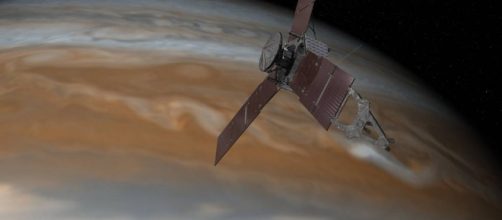People have had an image of Jupiter as a huge, gas giant with bands of clouds and the big, red spot ever since Galileo peeked at it through his telescope just over 500 years ago. While space probes like Pioneer, Voyager, and Galileo have vesting increased out knowledge of the biggest planet in the Solar System, the latest visitor from Earth to come to Jupiter, Juno, has given us a look never before available at that planet’s poles.
The biggest cyclones ever discovered
The familiar Jupiter of colored bands is not present when one looks at its poles.
Instead Juno has found massive cyclones, some of them hundreds of miles wide, swirling about the poles at unimaginable speeds. No one knows what drives these massive storms or if they tend to be stable over any appreciative time period.
Auroras not quite like Earth’s
Scientists already knew that Jupiter had auroras around the poles, but thought that they might be similar to Earth’s. The auroras on Earth are caused when its magnetic field channels charged particles from the solar wind up to the poles, causing a heavenly glow called the northern lights and the southern lights. However, Juno has discovered that the particles that cause Jupiter’s auroras are different in many ways than the ones that causes the ones on Earth.
They do not behave in the same way, something that has scientists puzzled to some extent.
Other discoveries
Juno has also looked into concentrations of ammonia and water in Jupiter’s atmosphere. The space probe has discovered that levels of ammonia vary from place to place, why no one knows. Juno has also found that Jupiter’s magnetic field us twice as powerful as scientists have hitherto believed. Like many discoveries, what Juno is making is creating as many questions as answers.
Juno’s mission continues
Juno was launched from Earth in August 2011 and arrived in Jupiter space in July 2016. It settled into a polar elliptical orbit around the gas giant where it is taking periodic dips into the intense radiation zones close to the poles of Jupiter before flying out toward safer zones farther away.
It is looking at Jupiter’s atmosphere, magnetic field, gravity field, and polar magnetosphere. Barring any accident or malfunction, Juno will continue its mission until at least February 2018. When the space probe reaches the end of its operational life, it will be sent crashing into Jupiter’s atmosphere. Juno, the latest of NASA’s New Frontier probes, was named after the Roman goddess considered the wife of the god Jupiter.


